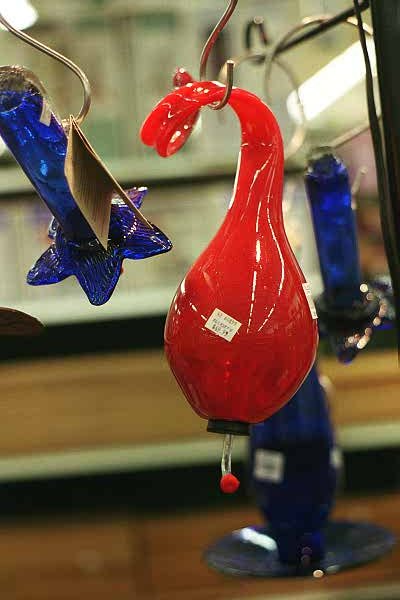|
FOUNTAINS are enormously popular right
now, small, medium and large, mostly for indoor use. Metal,
granite, marble, and cast stone. Not a lot of glass that I have
seen.
These consist of a pump in a base container to hold the
recirculating pump, total water supply, decorative rocks or other
materials, and some sort of play surface for the water. I almost
bought a hammered copper sphere that had a bubble of water out
the top into a black bowl with stones, but someone got it on my
day off. 2001-03-02
Some of the most popular fountains are small walls with water
burbling from a slot at the top. These would be possible with
sagged/fused glass, but I don't feel they would be very effective
in glass. A stack of glass might be effective, simply cut,
chipped, and stacked like rocks, but perhaps very sharp. I have
thought previously about folded bowls with water falling from one
to the next, but perhaps hard to do on a small scale (but
certainly, I am working in a small scale, so why not?)
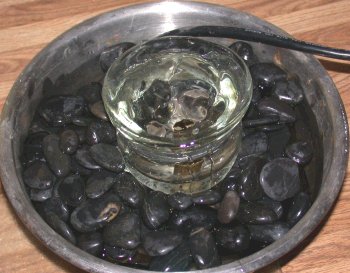 I
finally used the 1/2" core drill I bought years ago and combined it with a bowl,
a pane of black glass, rocks and a pump to make in indoor fountain. The
result is shown at right (click) and the construction details
here. Better with a pottery bowl below and hiding the cord, which is
very stiff. [More flexible are available.] 2007-06-12 In having the thing on the dining room table, the first
thing I did was turn the water volume down with a lever on the pump - it was too
noisy and sloppy. The second thing I did was extend the water feed with a
clear plastic tube because the flow was too quiet. The next thing I expect
to do is mount this bowl in another bowl so I can tilt this one slightly.
Unless perfection is at hand, the lip of the bowl resting on the edge of a cut
tube of PVC is hardly likely to be level. Level would have water able to
drop down any side, perhaps irregularly. Besides the water sound, there is
a low steady hum of the pump - the bowl rests on a hot pad cushion to reduce
that. The brass tube fits in the drilled hole but is not sealed, when the power
is off, the water drains from the glass bowl fairly quickly. -06-14 I
finally used the 1/2" core drill I bought years ago and combined it with a bowl,
a pane of black glass, rocks and a pump to make in indoor fountain. The
result is shown at right (click) and the construction details
here. Better with a pottery bowl below and hiding the cord, which is
very stiff. [More flexible are available.] 2007-06-12 In having the thing on the dining room table, the first
thing I did was turn the water volume down with a lever on the pump - it was too
noisy and sloppy. The second thing I did was extend the water feed with a
clear plastic tube because the flow was too quiet. The next thing I expect
to do is mount this bowl in another bowl so I can tilt this one slightly.
Unless perfection is at hand, the lip of the bowl resting on the edge of a cut
tube of PVC is hardly likely to be level. Level would have water able to
drop down any side, perhaps irregularly. Besides the water sound, there is
a low steady hum of the pump - the bowl rests on a hot pad cushion to reduce
that. The brass tube fits in the drilled hole but is not sealed, when the power
is off, the water drains from the glass bowl fairly quickly. -06-14
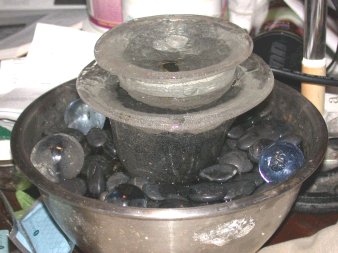 If the
sound of water is desirable, then there must be some water for other
water to fall into. This may not be obvious if you have seen noisy
fountains that rattle water down rocks. In my case, when the water was up
close to the sheet of glass, and the flow from the bowl is down the sides, there
was little noise (and I didn't want a high fountain also splashing on the
table.) When I needed to repair the pump, I put it back with less
water and it makes a nice sound of the water dripping off the edges of the plate
into the water below. If the water were falling from the rim of the bowl,
then water surrounding the rocks could supply the noise. -06-16 I took two
bowls with flat rims which nested nicely and drilled them in line. Neither
bowl had the bottom parallel with the rim and both were made with bubbly glass
instead of the clear above.. A few rocks under the larger bowl and many
rocks inside it around the tube allow leveling of the rims for even water flow
and best sound.. If the
sound of water is desirable, then there must be some water for other
water to fall into. This may not be obvious if you have seen noisy
fountains that rattle water down rocks. In my case, when the water was up
close to the sheet of glass, and the flow from the bowl is down the sides, there
was little noise (and I didn't want a high fountain also splashing on the
table.) When I needed to repair the pump, I put it back with less
water and it makes a nice sound of the water dripping off the edges of the plate
into the water below. If the water were falling from the rim of the bowl,
then water surrounding the rocks could supply the noise. -06-16 I took two
bowls with flat rims which nested nicely and drilled them in line. Neither
bowl had the bottom parallel with the rim and both were made with bubbly glass
instead of the clear above.. A few rocks under the larger bowl and many
rocks inside it around the tube allow leveling of the rims for even water flow
and best sound..
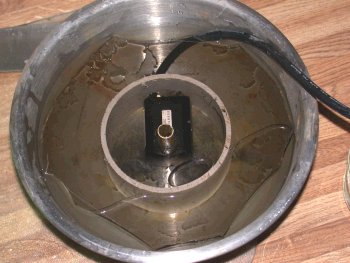 The end of the brass tube is just visible in the center of the upper bowl.
I found that having the tube come up inside stabilizes the bowl and allows a
nice surface burble. The lower picture has begins details of assembly. The pump
has been positioned and a length of 4" PVC pipe placed over it. A wide
notch accommodates the cord and narrow notches admit water while keeping out
rocks, etc. The holes drilled and the outside of the pump tube are 1/2" (12.7mm)
so thin wall half inch ID vinyl tubing and thin wall 1/2" OD brass tubing were
pulled from supply (junk) drawer. The plastic tubing slipped over the pump
tube was long enough to reach the edge of the PVC. A length of brass tube
fits inside and projects through the bowl bottom far enough to take another
plastic tube which is short enough to fit between the bowls. Another brass
tube carries the water through to the top bowl and a final plastic sleeve could
be added to bring the water closer to the surface. The alternating
connection of brass and plastic allows some adjustment for height although I
found it useful to make the plastic end just below the upper bowl and the brass
tubes to be short enough to just firmly grip the plastic (about 1/2" insert.)
2007-06-27
The end of the brass tube is just visible in the center of the upper bowl.
I found that having the tube come up inside stabilizes the bowl and allows a
nice surface burble. The lower picture has begins details of assembly. The pump
has been positioned and a length of 4" PVC pipe placed over it. A wide
notch accommodates the cord and narrow notches admit water while keeping out
rocks, etc. The holes drilled and the outside of the pump tube are 1/2" (12.7mm)
so thin wall half inch ID vinyl tubing and thin wall 1/2" OD brass tubing were
pulled from supply (junk) drawer. The plastic tubing slipped over the pump
tube was long enough to reach the edge of the PVC. A length of brass tube
fits inside and projects through the bowl bottom far enough to take another
plastic tube which is short enough to fit between the bowls. Another brass
tube carries the water through to the top bowl and a final plastic sleeve could
be added to bring the water closer to the surface. The alternating
connection of brass and plastic allows some adjustment for height although I
found it useful to make the plastic end just below the upper bowl and the brass
tubes to be short enough to just firmly grip the plastic (about 1/2" insert.)
2007-06-27
I have fused several panels from 1/4" plate glass with shapes on them to
make tilted water features in rectangular containers. By using a ceiling light
grid on the ends of three sections of PVC pipe, one of which is big enough to
hold the pump (from fountains above), but doesn't need to be, rocks or marbles
can be distributed to hide the works. The riser consists of 1/2" OD Plexiglas
tubing with 1/2" ID vinyl sections to fit over the pump outlet and extend the
tube to tilt it and slow the narrow flow. Water burbles down the slope
shifting paths which can be changed by moving the glass sideways. The
details of the design are to keep the water directed down the center although
slight movements of the glass produce different flow patterns. 2007-09-18
|

 If the
If the

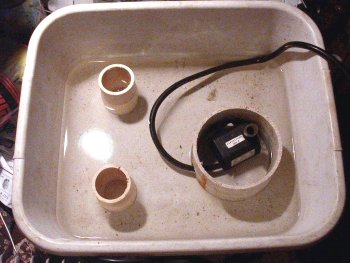
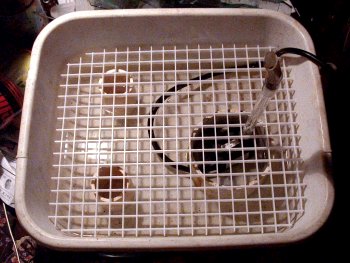
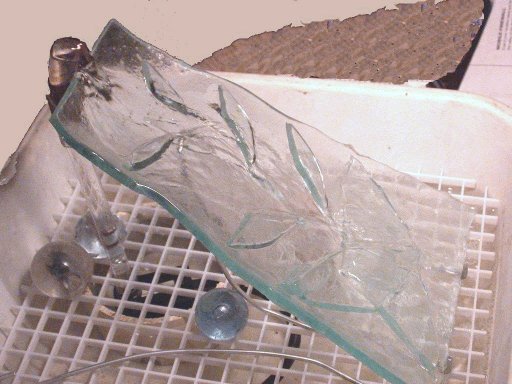
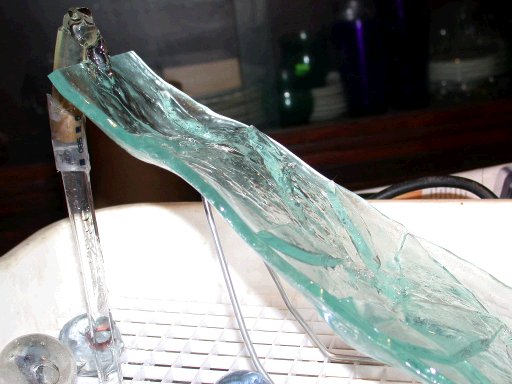
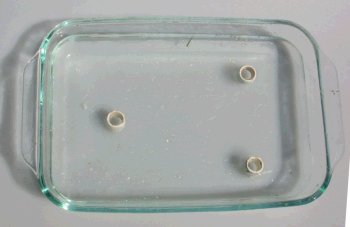
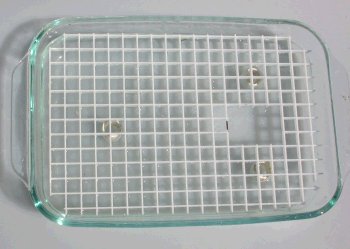
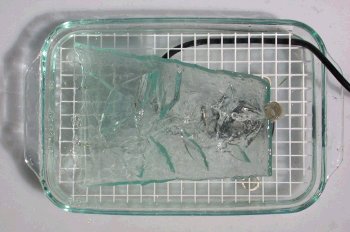
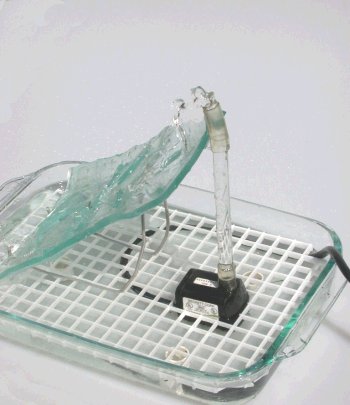
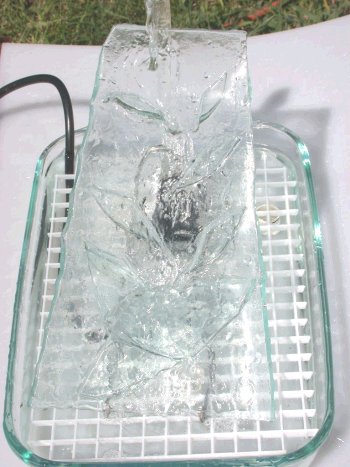
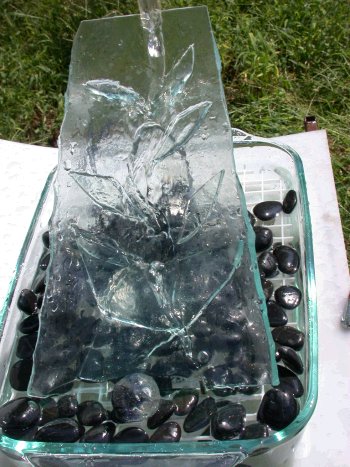
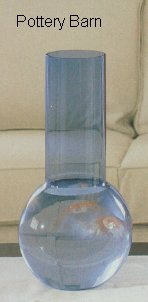
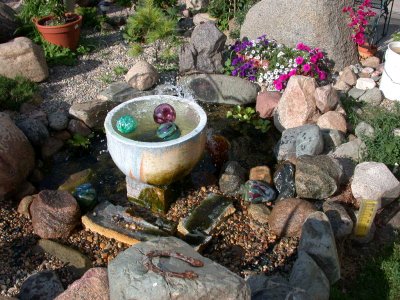 On my
trip to Minnesota in 2005 several of the studios had decorations made of
crucibles no longer used. This one a White Pine Studio had water splashing
and sealed glass balls floating on the water. Another studio had glass
balls floating at the foot of a tumbling water rapids (missed the photo somehow)
2005-08-13
On my
trip to Minnesota in 2005 several of the studios had decorations made of
crucibles no longer used. This one a White Pine Studio had water splashing
and sealed glass balls floating on the water. Another studio had glass
balls floating at the foot of a tumbling water rapids (missed the photo somehow)
2005-08-13